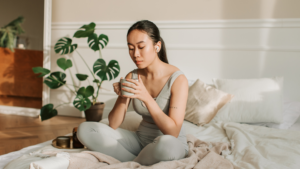Most yoga practitioners know to start with the basics-yoga, breathing, and meditation. Then you move on to more challenging poses-such as inversions and arm balances-which engage more of the muscles in the body. But what about strengthening the muscles in your yoga practice? Yoga postures such as inversions and arm balances engage the muscles in the arms and legs, but we tend to ignore the muscles that we use in everyday life.
Have you ever tried to build strength in your yoga practice? Have you ever felt that your practice was lacking in some way? If you answered yes, you are not alone. Enhancing your skills and deepening your yoga practice is a common aspiration for many yoga enthusiasts. Whether you’re attending a yoga class or practising at home, focusing on building strength can bring a transformative element to your routine.
That being said, yoga is a great way to build strength in your body, but many people are struggling with not being able to build muscle. This is largely due to the fact that most people are using their practice to relax. This is often the point of yoga.
Here are some tips for you to follow:
Proper postures
There are many ways to build strength and flexibility with your yoga practice. Each has its own purpose and can be used to complement your daily routine. The poses you choose, the duration of the practice, and the intensity you apply all directly impact your body. If you’d like to see your practice progress in a healthy direction, you’ll want to take a look at the different ways you can adjust your postures.
Excess Outside Your Normal
Starting a yoga practice is a great way to start if you want to be a fitness athlete. This is a skill that can be practiced every day and will benefit your physical and mental health in many ways. When you start it, you might think it’s hard to become a yoga athlete, but with a little time and effort, you can achieve your fitness goals.
Vary the load
The human body is a complex machine that is programmed to adapt to the loads we place on it. That’s why, when you do the same exercise routine over and over again, the muscle gets strong, but it’s not growing anymore. In order to build muscle, you have to vary the load each time you perform an exercise. In order to build strength, you have to vary the load to a certain degree.
Just because you are a beginner does not mean you can’t strengthen your yoga practice by adding more variety to your practice. If you are limited in shoulder width, it is possible that the traditional poses are making it more difficult for you to do your poses. Try reversing or side-bending poses to stretch your shoulders.
Have a strong balance
When one thinks of yoga as a ‘stretchy’ discipline or as a physical exercise, it is often easy for those with a limited understanding of yoga as a spiritual practice to dismiss it as a form of exercise. However, this is a very dangerous and ignorant attitude. The philosophy and practice of yoga are much greater than physical exercise and are a much more profound and comprehensive way to achieve much more than physical fitness. With a much deeper knowledge and understanding of the meaning and essence of yoga and the ‘spiritual practices’ within it, one will be able to flourish from a place of deeper balance and understanding of the nature of yoga. This will ultimately allow one to move to a place of deeper self-knowledge and self-love.
Slow down
If you’ve been practicing yoga or Pilates for a while, you know how it can build strength in your muscles, but it can also overwork joints, leaving you with aches and pains. This is where yoga can prevent injury, while Pilates can help prevent injury. When we practice it, we focus on the breath and the movements we make to achieve that moment of nirvana. We do this with awareness and humility. Practicing yoga regularly can also promote mindfulness and make one calmer. It also helps balance one of the most important nerves of our body, the vagus nerve, and improves the vagal tone for overall health. When we go too fast, we lose the ability to control our movements and miss the mind and body connection. The most important aspect of yoga is not the poses themselves but the physical poses themselves. It’s what happens in between the poses that define our practice.
Yoga is a great way to help you build strength and flexibility, but building strength with your practice is more than just improving your flexibility. Strength and flexibility both play a role in how and where you experience pain and injury, and building strength can help you avoid both.



